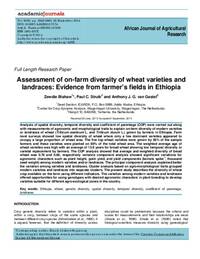Assessment of on-farm diversity of wheat varieties and landraces: Evidence from farmer’s fields in Ethiopia

Authors:
Analysis of spatial diversity, temporal diversity and coefficient of parentage (COP) were carried out along with measurements of agronomic and morphological traits to explain on-farm diversity of modern varieties or landraces of wheat (Triticum aestivum L. and Triticum durum L.) grown by farmers in Ethiopia. Farm level surveys showed low spatial diversity of wheat where only a few dominant varieties appeared to occupy a large proportion of wheat area. The five top wheat varieties were grown by 56% of the sample farmers and these varieties were planted on 80% of the total wheat area. The weighted average age of wheat varieties was high with an average of 13.8 years for bread wheat showing low temporal diversity or varietal replacement by farmers. The COP analysis showed that average and weighted diversity of bread wheat was 0.76 and 0.66, respectively variance component analysis showed significant variations for agronomic characters such as plant height, grain yield, and yield components (kernels spike-1, thousand seed weight) among modern varieties and/or landraces. The principal component analysis explained better the variation among varieties and landraces. Cluster analysis based on agro-morphological traits grouped modern varieties and landraces into separate clusters. The present study describes the diversity of wheat crop available on the farm using different indicators. The variation among modern varieties and landraces offered opportunities for using genotypes with desired agronomic characters in plant breeding to develop varieties suitable for different agro-ecological zones in the country.
